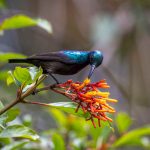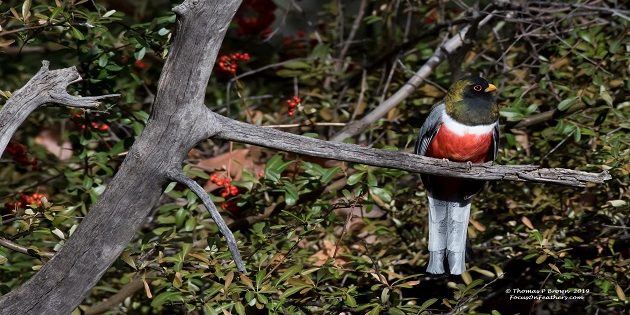The Western Scrub-Jay (Aphelocoma california) is a non-migratory member of the Corvidae family found in scrub and dry woodlands of oaks and piñon pine from Washington to Baja California. They are omnivorous and opportunistic feeders, taking mostly arthropods and fruit in the spring and summer and nuts like acorn and pine in the fall and winter. Click on images for full sized photo.
These clever birds store individual food items for later consumption and use spacial memory to retrieve cashed seeds and other stored items. Up to 6,000 piñon seeds or 5,000 acorns may be cached per individual in one autumn1. They have also been observed to recashe items if another jay had seen their stash place, once that observer was gone, thus avoiding their stash being pilfered.
They have also learned how to hang upside down and feed from my suet feeder. It doesn’t take long for a half dozen Western Scrub-Jays to finish off a suet block.
httpvh://www.youtube.com/watch?v=i0jcJb-YEO0
They are beautiful birds in the own right and lots of fun to watch as they come screaming into the feeding station, scaring the songbirds away momentarily as they hop from branch to branch, grabbing beaks full of sunflower seed from the feeders or from the ground, sometimes being chased off by other, apparently more dominant conspecifics.
Obviously, being closely related to magpies and crows, these birds are smart and resourceful but their antics and bright colors make them even more fun to have visiting your back yard.
To see the Island Scrub-Jay, listed as vulnerable due to the fact that they are found only on Santa Cruz Island, off the coast of California, check out Corey’s post. If you want to see more great bird photos, check out World Bird Wednesday.
References:1 Birds of North America Online
















Beautiful photos of the Jay and what fun to watch all its antics.
Such a beautiful looking bird, and intelligent too.
I love his blue colour.
Absolutely beautiful bird and excellent photos. That is a stunning shade of blue.
What a great post Larry! Your pictures are excellent and your text is an informative introduction to this fascinating Jay. Nice video too!
Hiya Larry,
Pity we never get to see these exotic US birds.
That blue is almost a faded jeans colour.
Like the lay-out of your pages .
Lovely birds Larry and great images. It’s a bird I have never seen so thanks for sharing.
Great post, Larry!
I have seen these jays appear to dig fake holes for non-existent food, and then bury a real nut somewhere else. A great trick!
They are beautiful and smart!
I love Jays 🙂
Lovely shots and post, Larry!
🙂
awesome pictures
My friend Bingo is a Western Scrub Jay here near Yosemite National Park where we live. He is the “boss man” of all the Jays in our immediate area, and as such was very eager to accept unshelled UNSALTED peanuts, which we buy for a song (currently $1.22/lb) at the local grocery store).
For the past 5 years, I go out a couple times a day with my bag of peanuts, and I’ve learned his call, so a couple of tries and he comes flying in, lands on my knee and I hold about 3 or 4 peanuts in the palm of my hand. He takes one, flies away and buries it, then comes back for more. As with a dog, when he takes a peanut from me, I always say “Good boy!” and now he flies to a nearby tree and sits on a branch waiting for me to say “Good Boy!” then he flies down and grabs the peanut. To my knowledge, he has had 3 wives over time, and at least 6 children. None of the others seem particularly interested in my peanut handouts, preferring, instead, to dig up dad’s caches throughout the local lots and meadows. It is said a Scrub Jay can remember caches of up to 2,000 locations! I can’t remember what I did yesterday!